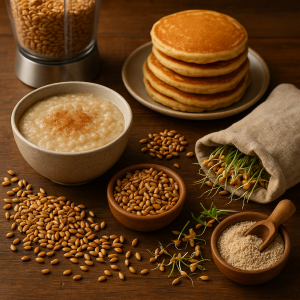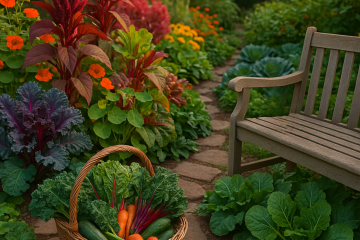
The many uses of wheat
When most people hear “wheat,” they think of either a loaf of bread or the thing they’re trying to avoid to fit back into their jeans. But if you’ve got a bucket of wheat kernels stashed away, you’re holding a bona fide preparedness treasure chest.
These little grains aren’t just flour waiting to happen—they’re versatile, shelf-stable, and ready to shine in ways that would make your sourdough starter jealous. From hot cereal to sprouting, from bread to blender pancakes, wheat is the pantry overachiever that never takes a sick day.
1. The Storage Superstar
Wheat kernels are the Meryl Streep of long-term pantry goods—legendary, reliable, and still stealing the show after decades.
-
Shelf life: Up to 30+ years when stored cool, dry, and oxygen-free.
-
Container: Mylar bags in buckets or sealed #10 cans.
-
Variety: Hard red, hard white, soft white, spelt, kamut—each with its own flavor and best uses, but all equally loyal in storage.
Bread goes stale. Pasta gets buggy. But wheat kernels? They sit patiently in your pantry, waiting for their big break like understudies with perfect pitch.
2. Grind It into Flour (Obviously)
The classic use is milling wheat into fresh flour. If you’ve never baked with freshly ground flour, brace yourself—it’s like tasting bread for the first time after a lifetime of eating packing peanuts.
-
Hard red wheat → hearty breads.
-
Hard white wheat → mild sandwich loaves, pancakes, everyday baking.
-
Soft white wheat → pastries, muffins, and tender treats.
A quality grain mill or a strong blender turns wheat into flour in seconds. And fresh flour = better flavor, better nutrition, and fewer “what is this even made of?” questions.
3. Use Them Whole in Blender Pancakes
This is a game-changer. You can toss whole wheat kernels straight into your blender, add your wet ingredients, and blend until smooth—no pre-grinding, no fuss.
The result? Fluffy, hearty pancakes that even picky eaters love. Check out my cookbook for the recipe!
4. Homemade Wheat Cereal — Cozy, Cheap, and Shelf-Stable
Before the cereal aisle turned into a sugar-coated circus, families made their own hot wheat cereal at home—and it’s shockingly easy.
Basic Creamy Wheat Cereal
Ingredients:
-
1 cup wheat kernels
-
4–5 cups water
-
Pinch of salt
Instructions:
-
Blend the wheat: Toss the wheat kernels into a blender with 1–2 cups of water and blend until it looks like coarse cream of wheat.
-
Cook it: Bring the rest of the water and salt to a boil, then slowly whisk in the blended mixture.
-
Simmer: Reduce heat and cook 10 minutes, stirring often, until smooth and creamy.
Optional upgrades: cinnamon, vanilla, honey, cream, or a sprinkle of brown sugar for that warm, nostalgic flavor.
This is the kind of breakfast that hugs you from the inside out. And since wheat kernels last decades, you’ve basically got an endless cereal supply without a single cartoon mascot.
5. Cook Them Like Rice for Salads, Pilafs, or Breakfast Bowls
Cooked wheat berries are chewy, nutty, and surprisingly flexible.
-
Basic method: Simmer 1 part wheat to 3 parts water or broth for 45–60 minutes until tender.
-
Toss them with olive oil, lemon, and feta for a Mediterranean salad.
-
Sweeten with fruit and honey for a warm breakfast bowl.
-
Mix with herbs and onions for a filling side dish.
Think of them as rice’s older, wiser cousin with better fiber.
6. Sprout Them for Extra Nutrition
Sprouting wheat is like unlocking its hidden superpowers.
-
Rinse and soak overnight.
-
Rinse twice a day until little tails appear (2–3 days).
-
Eat raw in salads, dry and grind for sprouted flour, or bake into sprouted breads.
Sprouting boosts nutrients and makes wheat easier to digest. It’s the pantry equivalent of a glow-up.
Nutrition Bonus: Wheat with Superpowers
Here’s the jaw-dropper: sprouted wheat actually develops Vitamin C, which dry wheat doesn’t have at all. As the kernel transforms from a dormant grain into a living plant, enzymes activate and nutrients shift. Sprouting increases the availability of B vitamins, makes minerals like iron and zinc easier to absorb, and turns your stored grain into a mini produce aisle—without a single grocery trip.
In other words, you’re not just eating a grain anymore… you’re eating something that’s biologically alive and nutritionally upgraded.
7. Roast and Grind for “Coffee” (Minus the Caffeine)
Roast wheat kernels until dark and fragrant, grind them, and brew like coffee.
You’ll get a warm, toasty beverage that’s surprisingly satisfying—especially during power outages or “no coffee in the house” emergencies. (Steve would probably call it Wheaties Roast: Apocalypse Blend.)
8. DIY Wheat Packs, Scrubs, and More
Wheat’s usefulness doesn’t end at the table:
-
Heat packs: Sew wheat into fabric pouches, microwave for 1–2 minutes, and use as a reusable heating pad.
-
Exfoliating scrubs: Mix finely ground wheat with honey or yogurt for a gentle face scrub.
Even your spa day can be shelf-stable.
The Kernel That Keeps on Giving
Wheat kernels are the quiet backbone of preparedness. They prove that resilience isn’t about flashy gadgets—it’s about understanding what lasts and using it creatively.
From pancakes to porridge, from bread to beauty scrubs, wheat doesn’t just feed bodies; it builds capability, one scoop at a time.
Wheat kernels aren’t just a prepper staple—they’re a lifestyle ingredient. With a little know-how, they become breakfast, lunch, comfort food, coffee substitute, self-care, and barter all in one.
So crack open that bucket and put those golden grains to work. They’ve been waiting 30 years for this moment.


0 Comments